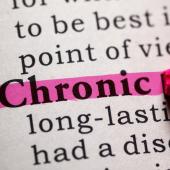Chronic infections can be caused by viruses, bacteria, fungi or even parasites. And beyond antibiotics, they can be very difficult to treat. In the first program of the series, we covered how to test for chronic infections and who is at risk.
In Part Two, we're back with Dr. Carissa Doherty to get “down and dirty” with the treatment strategies that she's found to be most effective in dealing with these seemingly intractable conditions.
Dr Carissa and her sister Dr Sonya Doherty are naturopathic doctors who opened The Natural Care Clinic in Burlington almost 20 years ago. Their approach in treating chronic illness has become world-renowned drawing patients from all over the world.
Key Take-Aways
Watch: All About Biofilm
Examples of Chronic Infection
Examples of chronic infections that everyone should be familiar with would be chronic ear infections, chronic urinary tract infections, and chronic yeast infections. Heartburn can also be understood as a chronic infection and even cold sores or herpes and Lyme disease.
Chronic vs Acute Infections
When a patient gets an ear infection and you treat it and they recover, that's an acute infection. But if they get the same ear infection in the same year multiple times in a short duration, that's a chronic infection.
If they flare in the fall or in the spring, that's when you think of chronic infection, especially if we see a very quick deterioration from someone who is normally well.
What is Biofilm?
The majority of chronic and recurrent microbial infections in the human body are caused by bacterial biofilms. Biofilm is alive. It's a set of organisms that act as a unit.
Think of biofilm as a house. There are three parties: the person, an infection and then there's biofilm, which is the third party.
We all have biofilms in us. The sinuses can be a biofilm. The digestive system, even joint spaces can be biofilm. But if you've got some sneaky, bad guys inside the biofilm, that's what becomes a little bit tricky.
They also have two walls: an outer wall and an inner wall. And behind those walls are where infections hide out in that “safe house”. If you kill things on the outside of the walls, you won't be able to eliminate them inside.
About 80% of chronic infections hide out in biofilm. It's one of the barriers to actually treating these infections effectively. This is also why it's important to prescribe a biofilm agent two weeks before testing. Tests will come back inconclusive if they can't penetrate the biofilm layer to access the infection.Microbial cells within biofilms have shown 10–1000 times more antibiotics resistance than other bacteria.
Biofilm and Antibiotics
Antibiotics will make a biofilm 10 to 20 times stronger. Unless the antibiotic is 100% successful at eliminating the infection, antibiotics strengthen biofilm.
Antibiotic resistance actually is born in the biofilm. Once inside the biofilm, microbes will drop their cell wall and exchange DNA with their buddies. Anyone inside there becomes more resistant and more persistent.
Therefore, if a patient is prescribed antibiotics, ensure that the dose is large and strong enough to 100% eliminate the infection. Always ensure that patients complete their antibiotic prescription for this reason.
Weaponizing Glutathione
Glutathione is a substance made from the amino acids glycine, cysteine, and glutamic acid. It is produced by the liver and involved in many body processes. The body uses glutathione to build tissues, repair them, make chemicals and proteins, and help its immune system function correctly.
The outer walls of the biofilm are susceptible to damage. Glutathione is actually one of those agents that can damage the outside of the biofilm. First, make sure there's not a deficiency, and then you can weaponize it to shred the outer wall of the biofilm. Also, glutathione is the king of the detoxification pathway.
Without glutathione, we can't engage in an active response to the infection. Those with low glutathione status struggle to kill viruses and viruses can be part of the chronic infection piece.
We weaponize glutathione to shred the outer wall of the biofilm. Oral glutathione works well but delivery by IV is a game changer. Sometimes we recommend direct glutathione but we also sometimes recommend precursors. For direct glutathione we go as high as 300 to 500, sometimes 1000 milligrams a day.
Liposomal glutathione refers to glutathione that has undergone a special process that encapsulates the glutathione molecule inside of a lipid. Doing this protects the glutathione and dramatically improves absorption.
NAC helps replenish glutathione and also helps to sequester excess glutamate in the production of glutathione. Glutamate is inflammatory and bad for the body, especially for the brain.
Watch: Strategies To Eliminate Chronic Infection
Eliminating Chronic Infection
Eliminating infectious agents hiding within biofilm requires a one-two punch. Phase one is to degrade the outer shell of the biofilm, while phase two is to penetrate the inner cell and kill the infection within.
PHASE 1
Phase one is pretty flexible. We use NAC and glutathione , but I also like aggressive herbs like black cumin oil and curcumin. Also St John's Wort because it's been shown to open up a viral biofilm, which is unusual. Ginger is another excellent weapon and even xylitol. These herbs act as anti-biofilm agents but also as “kill herbs” to eliminate the infection within.
PHASE 2
Depending on the makeup of the biofilm, there are cases when you must use a chelating substance like EDTA, MSA and DMSO to penetrate layers deeper within the biofilm.
You can also combine a chelating substance with bismuth and NAC with glutathione and alpha-lipoic acid to create a complex that acts as a chisel to degrade the biofilm
Another excellent biofilm combination is Dr Paul Anderson’s Biofilm Buster.
Carnitine Deficiency
Carnitine is an amino acid that is depleted in infection, and it is the bridge that puts nutrients into the cells. So if your carnitine bridges have been washed away, you can't actually put nutrients into the cells. And not just nutrients, kill herbs as well. In order that your kill strategy is efficient, you need to make sure that carnitine is not deficient.
Time Frame vs Adaptability
Measure the status of the ongoing success of your chronic infection fight using two indices: Feel Better or Aggravated. We will put a strategy in play for about three months and then measure the outcome. If the patient feels better and has fewer symptoms, we continue. If no change or aggravated symptoms, we change it up.
For large infections or infections that have taken hold over many years, it may take many months or even years to complete the treatment. The goal is to reduce the colony of infectious agents without doing harm to the patient.
Big Scary Infections. Big Scary Biofilm.
In patients with chronic infection, the biofilm may be embedded in the intestine and should be naturally pushed out through the digestive system. What'll happen is that layers of debris are like layers of cement and glue. That's where the biofilm is embedded. That's where the bad guys live. And if you can take that debris out, you're going to have a lot more success with your cases. If you can get that debris out, you're going to have a lot more success with your cases.
Using Zinc and Zinc Ionophores as Antivirals
Zinc in high concentrations inside a cell can stop DNA replication of whatever's inside. There has been lots of research on viruses, but there is also lots of research for other infections.
We use zinc in tougher cases if we have a viral presentation where we're doing bacterial kills and the person is still getting sick every four weeks with lots of congestion and mucus.
We make sure that the zinc levels are high enough to be a threat to the infections, but safe enough for the human body.
The key finding in our clinic during the pandemic is that when you combine zinc with a zinc bridge, or zinc ionophores, you can drive the zinc deep into the cell and it is more effective at preventing the virus from replicating.
Therefore zinc ionophores should be used with zinc supplements to act as antivirals. They have been shown to be very effective against many RNA viruses including SARS-CoV-2.
Quercetin is a natural compound that acts as zinc ionophore. So is curcumin.
Vitamin A
Vitamin A is depleted in infection just like carnitine, and it's underused as a viral killer. It's strengthening our immune system. We prefer the natural vitamin A found in cod liver oil.
As a viral killer, it's underused in our world. There's a small study from 2019 with Ebola patients and it decreased mortality.
We use 10,000 IU up to 100,000 IU for a short period of time. Do not use this on women of child bearing age.
Kill Herbs Recipe and Dosage
There are many kill herbs! The ones we've chosen today work well against viruses and bacteria.
We use a synergistic approach. Our formulations are super effective because of the entourage effect. The sum is more powerful and beneficial than the individual parts.
Also, use gel caps whenever possible especially for higher doses.
- St John’s Wort
150 to 300 milligrams twice a day - Licorice
100 to 300 milligrams twice a day - Andrographis
This is an antiviral and an antibacterial killer, and so it would be a 100 to 300 milligrams twice a day - Rosemary
Great for killing viral and bacterial infections. 300 or 500 milligrams twice a day - Thyme
250 milligrams twice a day - Juniper
20 milligrams twice a day.
Treatment Plan
We use cod liver oil to stabilize or strengthen the immune system. Unless you are a woman of children bearing age, we recommend 1 to 4 tablespoons. Use brands that offer a high vitamin A dosage.
Then we use Phase One anti-biofilm agents. We favor those that are high in essential oils due to the fact that the benzene ring will penetrate deeper into the biofilm. Ginger is an excellent example.
Then we use Phase Two anti-biofilm agents short term (about 1 to 3 months).
We assess for digestive function, make sure there's no constipation or fecal loading. Sometimes that will be an x-ray or what's called a “transit time test” where we track how long it takes food to pass through the digestive system.
Then comes the kill plan. We typically go in with five to ten kill herbs. We favor combinations for different purposes.
We cover all our bases by making sure the carnitine is not deficient and if necessary we supplement with zinc and zinc ionophores.
We also check for Postural tachycardia syndrome (POTS), which is an abnormal increase in heart rate that occurs after sitting up or standing. Some typical symptoms include dizziness and fainting. POTS can happen with infection and it messes up blood volume. So you have this nice little plan you've devised and not enough blood to deliver the plan.
Push vs Maintenanced Plans
We definitely have expectations of change within a month. It's a lot of work for the patient, it's a lot of supplements! Initially we go for a “Push Plan” and then we maintain it with a lighter kill plan for the duration.
We test for progress every three months to make sure our strategy is working. However, we don’t want the cost of killing to be borne by the body so we check for platelets and white blood cells every few months to make sure we are not going too fast.
Watch: Chronic Infection and Constipation
The Connection Between Chronic Infection and Constipation
The more we kill the infection, the worse the constipation or fecal loading, because the byproduct creates layers of stickiness in the digestive system. This is not constipation caused by motility or dehydration, it's more like the fecal matter is actually sticky and very difficult to move down the intestine. This type of debris that gets stuck in the digestive system takes a bit of work to remove. This can really stop someone from feeling better.
To test for constipation we can ask for a KUB x-ray. KUB stands for kidney, ureter and bladder. A KUB x-ray is more specific for fecal loading, and it will diagnose mild, moderate or severe. But stool should not be seen on an x-ray, so if it shows up, it's so old it's basically calcified.
You can have complete occlusion or only pieces of fecal matter stuck to the intestine or a narrowing of the pipes and actually have diarrhea as a symptom. These are all places that infection can breed. And it's not always easy to diagnose.
Another test is the transit test. Simply eat beets or corn and then start the clock till the last time the food shows up in the toilet bowl. This is the transit time. A healthy transit time is 8 - 18 hours. Anything more than 24 hours is a hard fail.
Treatment for Constipation and Fecal Loading
We recommend a two phase approach to get the debris out of the digestive system: hase One is disimpaction, and the second phase is maintenance therapy. We use osmotic water diarrhea agents, like magnesium oxide, to stimulate water to flush through the intestine.
The higher the dose of the agent, the more water flushes through to cause the debris to pull off. We don't want to mess up peristalsis, we don’t want to scratch the intestine, so in osmotic water diarrhea agent, we prefer magnesium oxide for that purpose.
Magnesium Oxide Dosing
Magnesium oxide at low doses is therapeutic, at high doses will trigger water through “the pipes”. So it is very safe.
Standard dosing is dependent on the level of constipation, and a trial dose of 1500 milligrams to 2000 milligrams should produce diarrhea or loose stool within an hour, or 2 to 5 loose stools, and the effect of the magnesium should be out of the body in 6 hours.
If you have a dose of magnesium and you're still having diarrhea two or three days later it means it's stuck in the body, still doing its job, pulling the hard stuff off the pipes.
Doses are based on your response. So if you have 2000 milligrams of magnesium but no output that day, you need that higher dose. So the doses can be up to 10,000 milligrams per day, 12,000 milligrams per day, just to get the bulk of the stool out. And then it's managed. So keep them as low as possible, but keep the debris coming out.
Typically a regular case would still take a couple of weeks or a couple of months to sort out the debris. The maintenance plan doses at about 800 milligrams per day.
Key Quote
“If you have an infection, then you'll have a mess being made. The infection makes a mess. Your immune system makes a mess. It’s just a big mess. That mess is naturally pushed out through the digestive system.
What happens in people with chronic infection is that the debris creates layers like pastry; cement, glue, cement, glue all stuck in the pipes. That's where the biofilm is embedded. That's where the bad guys live.
And if you can take that debris out, you're going to have a lot more success with your treatment.”
Dr Carissa Doherty ND
==
The opinions expressed in this Nutramedica program are those of the guests and contributors. They do not necessarily reflect the opinions of Nutritional Fundamentals For Health Inc.
This video is intended for licensed or registered health professionals and students of health professions only. These statements have not been evaluated by the Food and Drug Administration. Information contained in these programs are not intended to diagnose, treat, cure or prevent any disease.



